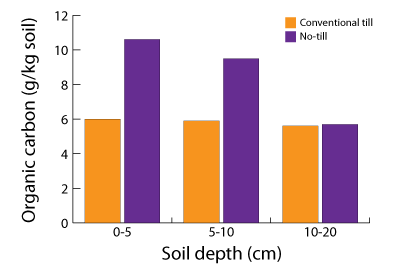Total Organic Carbon
What it is: Total organic carbon (TOC) is the carbon (C) stored in soil organic matter (SOM). Organic carbon (OC) enters the soil through the decomposition of plant and animal residues, root exudates, living and dead microorganisms, and soil biota. SOM is the organic fraction of soil exclusive of nondecomposed plant and animal residues. Nevertheless, most analytical methods do not distinguish between decomposed and non-decomposed residues. SOM is a heterogeneous, dynamic substance that varies in particle size, C content, decomposition rate, and turnover time.
Soil Organic Carbon (SOC) is the main source of energy for soil microorganisms. The ease and speed with which SOC becomes available is related to the SOM fraction in which it resides. In this respect, SOC can be partitioned into fractions based on the size and breakdown rates of the SOM in which it is contained (see table 1). The first three fractions listed are part of the active pool of SOM. Carbon sources in the active pool are relatively easy to break down.
SOM contains approximately 58% C; therefore, a factor of 1.72 can be used to convert OC to SOM. There is more inorganic C than TOC in calcareous soils. TOC is expressed as percent C per 100 g of soil.
| Table 1. Size and breakdown rates of various soil organic matter fractions. | |||
| Soil Organic Matter Fraction |
Particle Size (mm) |
Turnover Time (years) |
Description |
|---|---|---|---|
| plant residues | ≥ 2.0 | < 5 | recognizable plant shoots and roots |
| particulate organic matter | 0.06 – 2.0 | < 100 | partially decomposed plant material, hyphae, seeds, etc |
| soil microbial biomass | variable | < 3 | living pool of soil organic matter, particularly bacteria and fungi |
| humus | ≤ 0.0053 | < 100 – 5000 | ultimate stage of decomposition, dominated by stable compounds |
Why it is important: SOC is one of the most important constituents of the soil due to its capacity to affect plant growth as both a source of energy and a trigger for nutrient availability through mineralization. SOC fractions in the active pool, previously described, are the main source of energy and nutrients for soil microorganisms. Humus participates in aggregate stability, and nutrient and water holding capacity.
OC compounds, such as polysaccharides (sugars) bind mineral particles together into microaggregates. Glomalin, a SOM substance that may account for 20% of soil carbon, glues aggregates together and stabilizes soil structure making soil resistant to erosion, but porous enough to allow air, water and plant roots to move through the soil. Organic acids (e.g., oxalic acid), commonly released from decomposing organic residues and manures, prevents phosphorus fixation by clay minerals and improve its plant availability, especially in subtropical and tropical soils. An increase in SOM, and therefore total C, leads to greater biological diversity in the soil, thus increasing biological control of plant diseases and pests. Data also reveals that interaction between dissolved OC released from manure with pesticides may increase or decrease pesticide movement through soil into groundwater.Specific problems that might be caused by poor function: A direct effect of poor SOC is reduced microbial biomass, activity, and nutrient mineralization due to a shortage of energy sources. In non-calcareous soils, aggregate stability, infiltration, drainage, and airflow are reduced. Scarce SOC results in less diversity in soil biota with a risk of the food chain equilibrium being disrupted, which can cause disturbance in the soil environment (e.g., plant pest and disease increase, accumulation of toxic substances).
What you can do: Compiled data shows that farming practices have resulted in the loss of an estimated 4,400,000,000 tons of C from soils of the United States, most of which is OC. To compensate for these losses, practices such as no-till may increase SOC (figure 1). Other practices that increase SOC include continuous application of manure and compost, and use of summer and/or winter cover crops. Burning, harvesting, or otherwise removing residues decreases SOC.
For more information go to Soil Management Practices.

Figure 1. Effect of 10 years of conventional till and no-till on OC (calculated from SOM data in Edwards et al., 1999).
Measuring total organic carbon:
Presently, no methods exist to measure TOC in the field. Attempts have been made to develop color charts that match color to TOC content, but the correlation is better within soil landscapes and only for limited soils. Near infrared spectroscopy has been attempted to measure C directly in the field, but it is expensive. Numerous laboratory methods are available.
Edwards J.H., C.W. Wood, D.L. Thurlow, and M.E. Ruf. 1999. Tillage and crop rotation effects on fertility status of a Hapludalf soil. Soil Sci. Soc. Am. J. 56:1577-1582.
